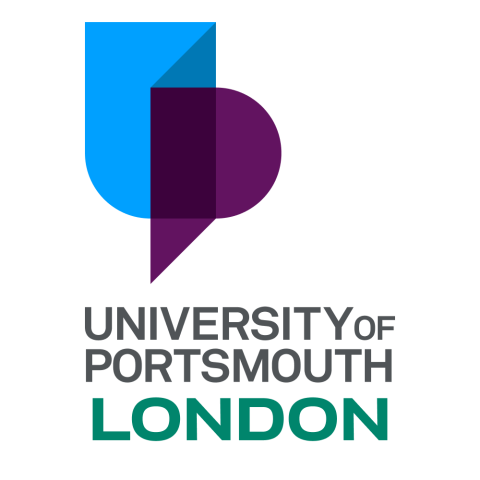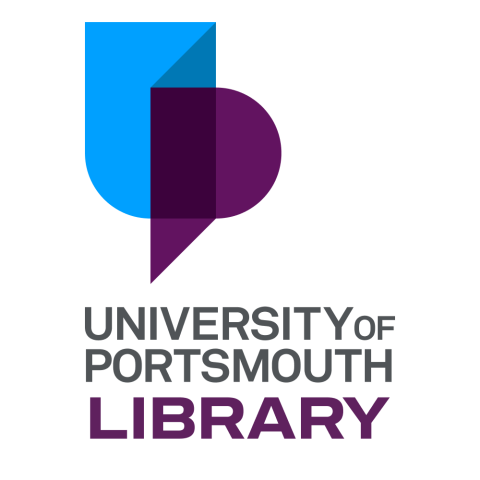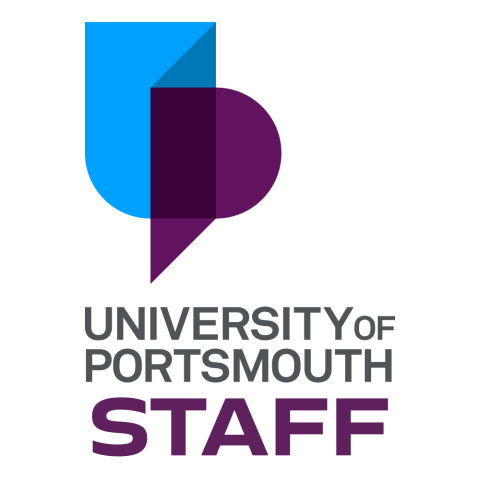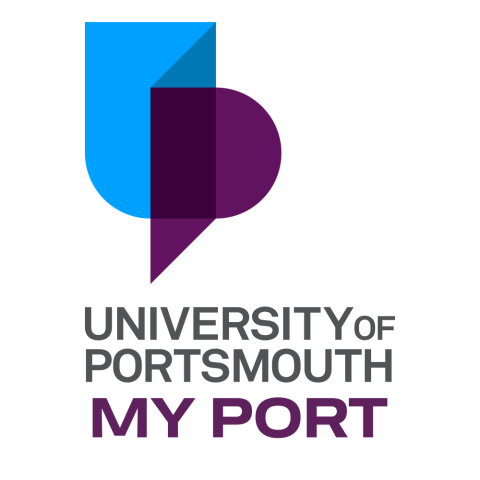
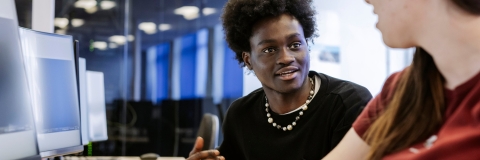
Digital Induction
Everything you need to know about IT at the University of Portsmouth, from your account, to emails, storage (OneDrive, N and K drives), software, security, internet access, and more.
Welcome to the University of Portsmouth, this page contains information on how to make best use of IT whilst studying at the University of Portsmouth.
If you need help with this page, please email digitalskills@port.ac.uk
Digital topics
To view information including short videos and written instructions, click on a topic below.
Please note that all our videos are produced with closed captions. To turn these on click on CC in the video player.
New students - activate your student account
If you’re joining the University for the first time, activate your University student account and then gain access to your Microsoft Outlook email account by following these steps:
1. Find your Student Number (it will be a seven digit number)
You’ll find this in the application email sent to your personal email address.
2: Activate your University Network Account
If you haven’t already done so, activate your student account to generate your University username and password.
-
Your username will look like: up1234567 (“up” followed by your student number)
3: Log into your Microsoft Outlook email account
Sign in to Outlook.com using your University email address and password.
-
Your email address will be: up1234567@myport.ac.uk (up followed by your own student number)
-
Your password is the same as the one you set up in step 2
-
Reset if you've forgotten your password (Note: you will need to wait approximately 30mins after changing your password for it to filter to Microsoft Apps)
4: Set up Multi-Factor Authentication (MFA)
On your first login, you’ll be prompted to follow the instructions to set up MFA.
5: Need Help?
If you need any support please contact IT support.
Continuing students
If you are a continuing student your email account will be migrated from Google Mail to Microsoft Outlook so please look out for an email to confirm the date for your migration. Until then, keep using Google as usual.
To access Outlook:
- Navigate Outlook.com and sign in with your University email and password.
- On your first login, you’ll be prompted to follow the instructions to set up MFA.
-
If you need any support please contact IT support.
For more information please visit Your move to Microsoft for more information.
There are several ways to get help with using IT while studying at the University.
-
IT Helpers
The IT Helper service, based in the University Library, is the main contact point for student IT support. The team offers friendly, hands-on help with a wide range of issues, including Wi-Fi, printing, account access, and using University software and services. It’s a space where students can get practical support, share experiences, and make the most of the University’s digital resources.
-
Service Desk Support
Phone Service Desk on 023 9284 7777 | Monday - Thursday - 08:00 - 17:00 (16:00 on Friday)
Start an online Chat to a Service Desk analyst
Raise a Ticket in the Self-Service Portal
You can store files on the University network via the N Drive and on your Microsoft OneDrive.
- For safety we recommend that you store important files / documents in two places.
- We do not recommend the use of removable storages devices as USB Memory Sticks often get lost and can become corrupt.
If you are using a University device always store a backup copy of any work in OneDrive.
Microsoft OneDrive
You can use OneDrive to store and access files from any device. Your OneDrive has a 5GB storage capacity. Sign in to OneDrive with your university email and password. You will need to set up MFA when using Microsoft for the first time, instructions can be found on this article.
N Drives
The N Drive is your personal networked storage area. This will always be available when you log into a standard PC or Mac on campus and files can be restored for up to 3 weeks after they've been modified.
- Your N drive is your network personal storage area. Your N drive has a 20GB storage capacity. Please note that your N Drive contains vital system configuration files. Please ensure you don't delete these.
For more information, please view the How to store you files article
The Digital Skills team provide resources and training to ensure you get the most out of the technology available to you at the University.
Trainer-led courses on key applications will be available to students later this year, please check the Digital Skills Page for updates.
To contact us please email digitalskills@port.ac.uk.
LinkedIn Learning
As a student at the University of Portsmouth you have access LinkedIn Learning. LinkedIn Learning is an online educational platform that helps you discover and develop business, technology-related, and creative skills through expert-led course videos.
The below is a brief introduction to LinkedIn Learning.
For more information, please view the LinkedIn Learning Page
You can raise a Service Desk ticket to either report a fault or get assistance from the Service Desk. Please try to add as much information as possible and suggest times/days when you are contactable.
- Visit Service Desk
- Click login to Self-Service
- Select Student from the drop-down list Click here to view image
- Click login with SSO Click here to view image
- Enter your university username and password
- Scroll through the list of options until you find report a fault
- Complete the form and click Finish
Student View is where you can manage many aspects of your course, including viewing modules, timetables and grades, updating your details, and applying for bursaries.
Useful Links
- The Your Student View page contains a comprehensive guide on Student View
- Student View Login
Your University Student Card is your passport to access a range of university buildings and services.
You should carry your card at all times on campus to use as:
- your library card
- your door access control card to University buildings
- your access to student services such as printing, laptop loans, catering loyalty points, sport and recreation and the University bus
- monitoring your engagement at on-campus events, exams and face-to-face classes
New students - getting your first card
You should apply for your student card before the start of the academic year as part of your initial registration process. You’ll be emailed separately with instructions, or follow the instructions for Joining the University, including photo upload and where to pick up your card when you’re on campus.
The University Student Cards page contains more details.
Multi-factor authentication (MFA) adds an extra layer of security when you sign in, helping to keep your accounts safe from unauthorised access. At the University, there are three types of MFA you might use, depending on the service:
- University MFA – Protects key University systems like VPN, Moodle, and secure services. Usually sends a one-time security code to your registered personal email address, but you can also use an authenticator app.
- Microsoft MFA – Secures Microsoft 365 services like Outlook, OneDrive, and Teams. We recommend using the free Microsoft Authenticator app, but you can also use other supported methods.
- Google 2-Step Verification – Protects your University Google account, including Gmail and Google Drive.
Each method works slightly differently, but the goal is the same, to make sure that even if your password is stolen, no one else can access your account.
For help setting up MFA, contact the Service Desk.
The wifi network used at the University is eduroam. It is available in all campus buildings and over 70 other locations in Portsmouth.
All you need to log onto eduroam is your University account username and password.
The Connecting to Campus WiFi Page contains more information on Connecting to Wifi, including Mac Instructions.
Windows 10 Instructions
- Click the Network Icon in the task bar.
- A list of available networks will be shown.
- Select eduroam and click on Connect.
- Enter your network account username with @port.ac.uk, e.g. up874068@port.ac.uk followed by your password, then select OK (do not use .myport.ac.uk)
- You should now be connected to eduroam
Windows 11 Instructions
-
Windows 11 WiFi settings can be found from the Network and Volume section of the task bar.
-
Select it to bring up a selection of controls and toggle on the WiFi, if not already on, then click the right arrow next to it to display the current list of available networks.
-
Select eduroam, tick Connect automatically, then select Connect.
-
Enter your network account username with @port.ac.uk, e.g. up874068@port.ac.uk followed by your password, then select OK (do not use .myport.ac.uk).
-
You should now be connected to the wireless network.
As a student at the University of Portsmouth, you will have access to additional security on your devices by using the Virtual Private Network (VPN). If you are working remotely, some of our services, such as AppsAnywhere will require you to be using the VPN.
Before you can use the VPN, you will need to download it.
- Go to student.vpn.port.ac.uk
- Sign in with your student username and password. (Your University username is your UPxxxxx).
- You will be asked to enter a One-Time Authentication Code. This will be sent by default to the email address you provided when you registered with the University.
- Type in this code and click Next.
- You will be presented with download options, pick the one that matches your operating system, download and install it.
- Open the VPN from your system (bottom right of your screen), clicking the up arrow and selecting the globe icon.
- When you first open the VPN you will be asked to enter a portal address. Enter student.vpn.port.ac.uk.
- Go to Connect to the VPN.
For more information, and how to use other operating systems, view the Guide to the Virtual Private Network.
There are 5 Open Access areas around the campus with over 600 PCs, Macs, short-loan laptops and printing facilities for you to use. They are located in; the Library, Park Building, Portland Building, Richmond and Anglesea Building.
Remote Access
If you're not on campus you can still access a University desktop to use specific software you may not have on your own device.
For a more detailed guide, including instructions for Mac users, please see the Remote Access to Lab Computers.
AppsAnywhere is the University Apps portal that allows you to stream apps and download software for study and work - available anywhere, on and off-campus, anytime.
- Open a new browser tab.
- Enter appsanywhere.port.ac.uk
- Log in using your University email and password.
- Click Sign In.
- Using the Search bar, start to type the name of the required software.
- If you are unsure, click the Apps List button and select View all apps.
Note: You can add a favourite once you have found the required software.
For more information on AppsAnywhere and other software, please view the Access and Download Software page
Zoom is used for all virtual sessions and can be accessed via a desktop or laptop as well as on a mobile phone.
- Visit the University Zoom link.
- Click Download - get the Zoom App.
- Select your device from the download centre.
- Install the App.
- Once downloaded, run Zoom.
- Login with your University email address (or username) and password.
Note:
- We recommend you use this installed version of Zoom to ensure the best sound and image quality.
- Your University Username is UP followed by your student number e.g. up874068@port.ac.uk
Cyber Security
Cyber security is one of the most important parts of using online devices and accounts. Below is a video to help you ensure you are safe online. If you have questions email digitalskills@port.ac.uk.
Below are some setting you can change in Windows 11 to aid accessibility.
For more help, please email digitalskills@port.ac.uk.
Changing the appearance of your mouse
- Click on Start Menu.
- Select the Settings Cog.
- Select 'Accessibility'.
- Select 'Mouse Pointer and touch' in the menu on the left hand side.
- A slider is available to change the size of the pointer.
- Select a colour for the mouse.
Text size
- Click on Start Menu.
- Select the Settings Cog.
- Select 'Accessibility'.
- Select Text cursor in the menu on the left hand side.
- Toggle the text cursor to on.
- Use the slider to control the size of the Text Cursor.
- Select a colour for the Text Cursor.
Audio
- Click on Start Menu.
- Select the Settings Cog.
- Select 'Accessibility'.
- Select 'Audio' in the menu on the left-hand side.
- Select 'Sound'.
The Disability Advice team supports students with disabilities or who require additional support for their academic studies. More information on contacting this team is on the Disability Advice page.
Moodle is available 24-hours a day, 7-days a week. You can access your course and module learning materials from Moodle via smartphone, laptop or desktop computer. You’ll only have access to Moodle once you have registered on your course.
Useful Links
The University Library is a central space for study, research and support. From solo studying to group work and research projects, our library has space and resources for study and work of all kinds.
Useful links
- For more information about the Library please see the University Library page
- Instructions for booking a group study area can be found on this page
As a student you will have access to the MyPrint service allowing you to send files to print, whilst on campus as well as from home to collect next time you come to the campus.
Instructions
- To print, select the VR-STUDENT-PRINT printer, and your printing will be held in a queue.
- To release your printing, swipe your student card at an available printer.
- Any printing not released after 24 hours will be cancelled.
- Your printing is managed via your MyPrint, where you can top up your print credits and manage your printing.
For more information on printing, view the Printing on Campus Page
Maps
The information below can be found on the Maps and Directions page:
- Campus maps to help you navigate the University.
- Details on travel options and how to get to the University campus.
Term dates
- Key dates page has all the key dates listed.

